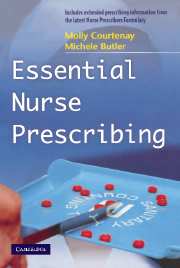Book contents
- Frontmatter
- Contents
- Preface
- Introduction
- 1 Basic Pharmacology
- 2 Preparations for the Prevention and Treatment of Infection
- 3 Preparations for Problems and Minor Ailments of the Nervous System
- 4 Preparations for Problems and Minor Ailments of the Digestive System
- 5 Preparations for Problems and Minor Ailments of the Respiratory System
- 6 Preparations for Minor Injuries and Minor Ailments of the Skin
- 7 Preparations for Minor Injuries of the Musculoskeletal System
- 8 Products and Preparations Affecting the Reproductive System
- 9 Preparations for Problems and Minor Ailments of the Urinary System
- 10 Preparations for Problems and Minor Ailments of the Sense Organs
- 11 Products and Preparations for Minor Ailments of the Circulatory System
- Index
Introduction
- Frontmatter
- Contents
- Preface
- Introduction
- 1 Basic Pharmacology
- 2 Preparations for the Prevention and Treatment of Infection
- 3 Preparations for Problems and Minor Ailments of the Nervous System
- 4 Preparations for Problems and Minor Ailments of the Digestive System
- 5 Preparations for Problems and Minor Ailments of the Respiratory System
- 6 Preparations for Minor Injuries and Minor Ailments of the Skin
- 7 Preparations for Minor Injuries of the Musculoskeletal System
- 8 Products and Preparations Affecting the Reproductive System
- 9 Preparations for Problems and Minor Ailments of the Urinary System
- 10 Preparations for Problems and Minor Ailments of the Sense Organs
- 11 Products and Preparations for Minor Ailments of the Circulatory System
- Index
Summary
In 1986, recommendations were made for nurses to take on the role of prescribing. The Cumberlege Report Neighbourhood Nursing: A Focus for Care (Department of Health and Social Security (DHSS), 1986), examined the care given to patients in their homes by district nurses (DNs) and health visitors (HVs). It was identified that some very complicated procedures had arisen around prescribing in the community, and that nurses were wasting their time requesting prescriptions from the general practitioner (GP) for such items as wound dressings and ointments. The report suggested that patient care could be improved, and resources used more effectively, if community nurses were able to prescribe, as part of their everyday nursing practice, from a limited list of items and simple agents agreed by the DHSS.
During 1989 a report was published which made a number of recommendations involving the categories of items for which nurses might prescribe, together with the circumstances under which they might be prescribed (Department of Health (DoH), 1989). The report suggested that a number of benefits would occur as a result of nurses adopting the role of prescriber. As well as improved patient care, this included improved use of both patients' and nurses' time and improved communication between team members.
During 1992, the primary legislation permitting nurses to prescribe a limited range of drugs was passed (Medicinal Products: Prescribing by Nurses Act 1992). The necessary amendments were made to this act in 1994 and a revised list of products available to the nurse prescriber was published in the Nurse Prescribers' Formulary (NPF) (see Table I.1).
- Type
- Chapter
- Information
- Essential Nurse Prescribing , pp. 1 - 5Publisher: Cambridge University PressPrint publication year: 2002



